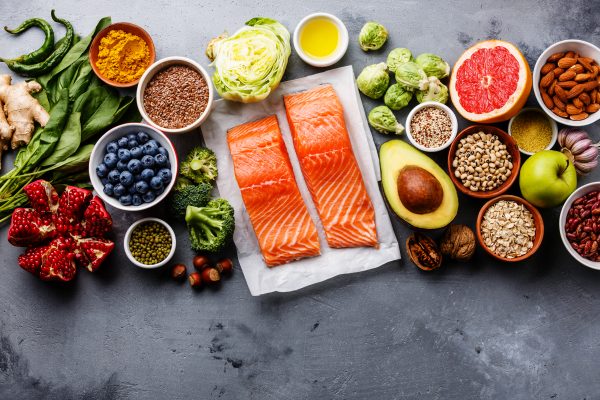When trying to lose weight, crafting a balanced plate is not just about what you eat, but also about how you portion your meals. Achieving the right balance of macronutrients—carbohydrates, protein, and fats—is essential for sustainable weight loss. When we talk about building a healthy plate, we’re not just focusing on the physical aspect of it; we’re also considering the nutritional value it provides to our bodies. Moreover, building a healthy plate isn’t just about restriction; it’s about abundance and variety, ensuring that you enjoy a wide range of flavors and textures with every meal.
How to Build a Healthy Plate
Each component of your plate plays a crucial role in fueling your body with the necessary nutrients while managing calorie intake. By understanding how to structure your meals, you can make informed choices that support your weight loss goals. So, let’s talk about how you can construct a plate that promotes healthy eating habits and aids in your weight loss journey.
Creating a healthy eating plate is more than just placing food on it—it’s about making thoughtful decisions that fuel your body with the right nutrients. Here are some critical guidelines to help you build a plate that supports your weight loss goals and promotes overall well-being:
- Eliminate Added Sugars: Refined sugars, abundant in foods like white rice or mashed potatoes, can wreak havoc on your blood sugar levels, leading to energy crashes and cravings. Instead of relying on these empty-calorie options, prioritize nutrient-rich whole grains like brown rice or quinoa. Not only do they provide sustained energy, but they also offer a wealth of vitamins, minerals, and fiber, keeping you feeling full and satisfied for longer periods.
- Opt for Healthy Fats: While fats are crucial for a balanced diet, it’s essential to choose the right kinds to support heart health and weight management. Swap out butter for healthier options like olive oil or avocado oil, which are rich in monounsaturated fats and have proven health benefits, including reduced inflammation and improved cholesterol levels. Incorporating sources of healthy fats into your meals can also enhance the absorption of fat-soluble vitamins like A, D, E, and K.
- Prioritize Vegetables: The USDA’s Dietary Guidelines for Americans (2020-2025) encourages the consumption of all types of vegetables. Non-starchy vegetables are, however, the unsung heroes of a healthy plate, offering a plethora of vitamins, minerals, and antioxidants to support overall health and well-being. When filling your plate, aim to make vegetables the star of the show, with at least half of your plate consisting of colorful veggies like spinach, broccoli, bell peppers, and carrots. These nutrient-dense powerhouses not only add volume and texture to your meals but also help control calorie intake by providing essential nutrients without excess calories.
- Include a Rainbow of Fruits: Fruits are nature’s candy, providing natural sweetness along with a plethora of vitamins, minerals, and fiber to support optimal health. Incorporating a variety of fruits of different colors into your diet ensures that you’re reaping the benefits of a wide range of nutrients, each with its unique set of health-promoting properties. From antioxidant-rich berries to potassium-packed bananas, aim to include a diverse array of fruits in your meals and snacks to satisfy your sweet tooth while nourishing your body from the inside out.
- Stay Hydrated with Sugar-Free Liquids: Hydration is key to overall health and well-being, yet many people overlook the importance of proper hydration when it comes to weight loss. Sugar-sweetened beverages like soda, fruit juice, and sweetened coffee drinks can add a significant number of empty calories to your diet, contributing to weight gain and sabotaging your efforts to achieve a healthy weight. Instead, opt for sugar-free beverages like herbal tea, sparkling water, or infused water to stay hydrated without the added calories. Not only will these options quench your thirst, but they’ll also provide additional health benefits like improved digestion and enhanced detoxification.
- Choose Whole Grains: Whole grains are an excellent source of complex carbohydrates, fiber, and essential nutrients like B vitamins and iron, making them a valuable addition to a healthy plate. Unlike refined grains, which have had their nutrient-rich bran and germ layers stripped from them, whole grains retain these valuable components, providing sustained energy and promoting satiety. Incorporating whole grains like quinoa, whole-wheat bread, and barley into your meals not only adds texture and flavor but also helps stabilize blood sugar levels and supports digestive health.
- Select Lean Proteins: Protein is an essential macronutrient that plays a crucial role in muscle repair and growth, hormone production, and satiety. When building a healthy plate, prioritize lean sources of protein such as poultry, fish, tofu, beans, and legumes, which are lower in saturated fat and calories compared to their higher-fat counterparts like red meat and processed meats. Not only do these lean protein sources provide ample protein to support muscle maintenance and repair, but they also offer additional nutrients like iron, zinc, and B vitamins, making them a valuable addition to any meal.
By incorporating these guidelines into your daily meal planning, you can create balanced meals that not only support your weight loss journey but also nourish your body with the essential nutrients it needs to thrive. Remember, building a healthy plate is not about restriction or deprivation—it’s about making informed choices that prioritize both your physical and emotional well-being.
How to Measure the Ideal Size of Food on Your Plate
Meal portions matter too, so remember to listen to your body’s hunger and fullness cues, and practice mindful eating habits. Don’t just make conscious choices about what you put on your plate and how you eat, but also how much. Minding the volume of your portions can help you cultivate a healthier relationship with food and achieve your wellness goals.
Proper portion control is key to managing calorie intake and achieving weight loss goals. Here are two methods to help you gauge the right serving sizes:
The Visual Portion Control Method
According to experts at the Mayo Clinic, larger portions naturally encourage greater food consumption behavior. Portion control doesn’t have to involve complex measurements or counting calories. Instead, it’s about using visual cues to estimate appropriate serving sizes. This method is particularly helpful for those who prefer a more intuitive approach to eating. By learning how to visually assess portion sizes, you can develop healthier eating habits without feeling deprived or restricted. Remember, practicing portion control is not about perfection; it’s about making gradual, sustainable changes to your eating habits.
Now, let’s talk about the visual portion control method in more detail:
- Plate Division: Imagine dividing your plate into sections: half for vegetables, a quarter for lean protein, and a quarter for whole grains. This simple visual guide can help you balance your meal and ensure you’re getting a variety of nutrients.
- Hand Comparisons: Use your hand as a reference point for portion sizes. For example, a serving of protein should be about the size of your palm, while a serving of carbohydrates should be roughly the size of your clenched fist. This method allows for easy portion estimation without the need for measuring cups or scales.
- Color Variation: Aim for a colorful plate by including a variety of fruits and vegetables. Different colors indicate different nutrients, so incorporating a rainbow of produce ensures you’re getting a wide range of vitamins, minerals, and antioxidants.
- Depth Perception: Consider the height of your food on the plate. Foods piled high may appear larger than they are, leading to overeating. Opt for flatter portions to keep your serving sizes in check.
In essence, the visual portion control method offers a flexible and practical approach to managing food intake. By integrating simple yet effective strategies like plate division, hand comparisons, color variation, and depth perception, individuals can develop a deeper understanding of portion sizes and make more mindful eating choices. This method encourages a focus on nutrient-rich foods while allowing for flexibility and enjoyment in meals.
Moreover, by honing the skill of visually assessing portions, individuals can navigate various dining situations with confidence, whether at home, restaurants, or social gatherings. Ultimately, adopting the visual portion control method empowers individuals to take control of their eating habits, fostering a healthier relationship with food and promoting overall well-being.
Next, let’s look at another method of portion control – the hand-portion control method – and how you can use it to create balanced meals.
Hard-Portion Control Method
The Academy of Nutrition and Dietetics offers some great tips for estimating portion size, by comparing your plate’s contents to everyday objects – like a tennis ball, a baseball, or a deck of cards. However, one practical approach to portion control is using your hands as a guide. This method is convenient and doesn’t require any special tools or equipment. By relying on the size of your hand, you can easily estimate appropriate serving sizes wherever you are. Whether you’re dining out at a restaurant or preparing meals at home, your hand can serve as a handy tool for portion control. With practice, you’ll become more confident in your ability to make balanced food choices that support your weight loss goals.
In addition to the methods mentioned above, here are four more hand-portion control techniques to consider:
- Finger Width: Use your fingers to gauge the width of certain foods. For example, a serving of cheese should be about the width of your thumb, while a serving of nuts should be roughly equivalent to the length of your index finger.
- Hand Stack: Stack your hands together to estimate the thickness of certain foods. For instance, a serving of meat should be about as thick as the palm of your hand when stacked.
- Hand Spread: Spread your hand out flat to estimate the surface area of certain foods. For example, a serving of vegetables should cover about the same surface area as your open hand.
- Hand Fist: Make a fist with your hand to visualize the size of certain foods. A serving of cooked grains or pasta should be about the size of your clenched fist, while a serving of peanut butter should be roughly equivalent to the size of your thumb.
Incorporating the hand-portion control method into your daily routine not only simplifies portion management but also promotes a healthier relationship with food. By leveraging the natural measuring tool of your hand, you gain a practical and accessible way to monitor your food intake without the need for intricate calculations or strict adherence to measuring cups. This method fosters a sense of empowerment as you become more attuned to your body’s needs and learn to make informed choices based on intuitive cues.
Keep in mind, that by practicing hand-portion control consistently, you can cultivate sustainable eating habits that support your overall health and wellness goals. So, embrace the simplicity and effectiveness of the hand-portion control method as a valuable tool on your journey to a balanced and nourished lifestyle.
Additional Tips for Weight Loss by Balancing Your Plate
Whether planning your weight loss journey, or simply striving for a healthier lifestyle, portion control is often at the forefront of dietary considerations. However, it’s essential to recognize that achieving a balanced plate goes beyond merely managing portion sizes. While portion control lays a foundation for mindful eating, incorporating other key principles can enhance the nutritional quality of your meals and support your overall health goals.
By focusing on factors such as nutrient density, listening to your body’s cues, and being mindful of hidden calories, you can optimize your dietary choices for long-term success. Let’s discuss a few additional tips that complement the concept of portion control and contribute to a well-rounded approach to healthy eating. Here are some additional guidelines to keep in mind:
- Focus on Nutrient Density: Prioritize filling your plate with nutrient-dense foods like fruits, vegetables, and whole grains. These foods are not only low in calories but also rich in essential vitamins, minerals, and antioxidants.
- Start Small, Add More: It’s better to start with smaller portion sizes and listen to your body’s hunger cues. If you’re still hungry after finishing your plate, you can always add more food. By tuning into your body’s signals, you can avoid overeating and promote mindful eating habits.
- Listen to Your Body: Pay attention to your hunger and fullness cues. Stop eating when you feel comfortably satisfied, rather than waiting until you’re overly full. By practicing mindful eating, you can develop a healthier relationship with food and improve your overall well-being.
- Beware of Hidden Calories: Be mindful of hidden sources of calories in your meals, such as sauces, dressings, and condiments. These extras can add up quickly and sabotage your weight loss efforts. Opt for lighter options or use them sparingly to keep your meals balanced and nutritious.
- Stay Consistent: Building a balanced plate is not just about making healthy choices occasionally; it’s about creating sustainable habits that last a lifetime. Stay consistent with your efforts, and remember that small changes add up over time. By prioritizing your health and well-being, you can achieve your weight loss goals and enjoy a happier, healthier life.
In the pursuit of a balanced diet and a healthier lifestyle, it’s crucial to embrace a holistic approach that encompasses various dietary considerations. Remember, achieving a balanced diet is not about perfection but rather about making informed choices that align with your health goals. Through dedication, mindfulness, and a commitment to lifelong wellness, you can nourish your body, achieve your weight loss aspirations, and enjoy a vibrant and fulfilling life.





